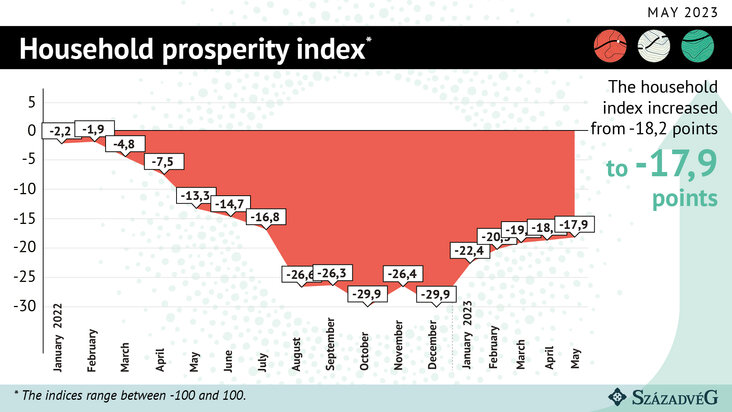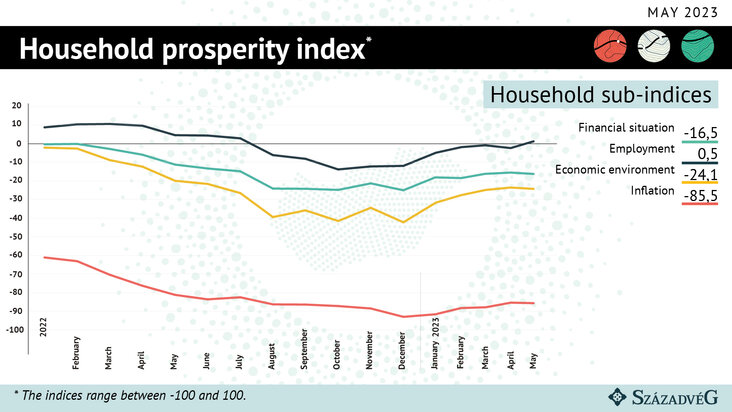According to the May 2023 survey of Századvég Konjunktúrakutató, the sense of prosperity among households and businesses has improved. The household index, measured on a scale of -100 to +100, improved slightly, from -18.2 to -17.9, while the business index improved significantly, from -13.2 to -10.4. The prosperity index remained in negative territory, driven by the Russian–Ukrainian war, a higher inflationary environment and uncertainty caused by economic sanctions. Less turbulence and falling prices in financial, foreign exchange and commodity markets than in previous periods, as well as a stronger forint exchange rate, have all reduced uncertainty. As a result, companies’ economic expectations are close to the level of a year ago. However, a stronger improvement in the sense of prosperity will only be possible if the war ends, inflation moderates more significantly after peaking, and energy prices become sustainably low.
Business sentiment has strengthened back to the level of a year ago


Three sub-indices of the household prosperity index worsened slightly and one improved significantly compared to the previous month, resulting in an overall slightly better index compared to April. Employment continues to be the most positively assessed, now positive at 0.5, up from -2.0 in the previous month. Households are most negative about inflationary developments, with this indicator weakening minimally from -85.0 to -85.5. The perception of the economic environment fell from -23.3 in the previous month to -24.1, while the financial situation improved slightly from -15.9 to -16.5.

For households, the biggest positive shift in May was in fear of redundancy. Of the people surveyed, 53.3% (up 3.8 percentage points from the previous month) are not at all worried about losing their own job or that of a family member in the next six months, while 21.6% (up 0.2 percentage points from the previous month) are rather not worried. 15.0% of respondents (down 1.2 percentage points from the previous month) said they were rather afraid of it, while 9.3% said they were very afraid of it (down 2.5 percentage points from the previous month).

The business survey showed an improvement in all four sub-indices from the previous month. The economic environment indicator improved from the previous month’s -23.0 to -17.8, the industrial environment indicator improved from -9.0 to -8.2, the production environment indicator improved from -9.4 to -7.3 and the business environment indicator improved from -21.2 to -17.9.

For companies, the most positive development was in terms of innovation-related developments planned by companies for the next year. In May, 24.5% of firms surveyed (up 4.3 percentage points from the previous month) said they planned to invest in innovation. In addition, only 72.7% say that they are unlikely, to varying degrees, to invest in innovation, down from 78.7% last month.
About the prosperity index
The purpose of the prosperity survey conducted by Századvég Konjunktúrakutató is to provide information to decision-makers and analysts on current and near-term economic developments. Since August 2019, our Institute has been producing the business and consumer prosperity index on a monthly basis. Our monthly survey asks 1,000 business leaders and 1,000 adult residents about their assessment of the economic situation and their expectations. For the two groups, we ask 29 and 28 questions respectively, covering a wide range of economic life. Among the responses received, positive ones (e.g. expected economic improvement) are given a positive score, while negative ones (expected decrease in employment) are given a negative score. The scores are then averaged and converted to a scale between -100 and +100 to obtain the prosperity indices. Thus, the higher the value of the prosperity indices, the more positive households’ and companies’ perception of the economy is. In addition, for both the household and the business survey, 4 sub-indices are constructed using a subset of the questions to illustrate the evolution of economic sentiment in a particular area.
